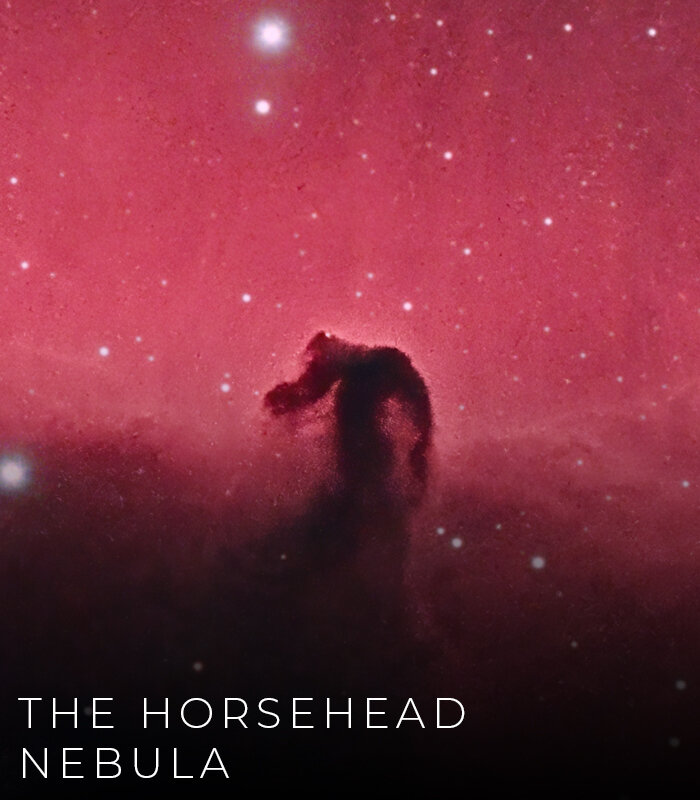Photographing the Horsehead Nebula
The Horsehead Nebula (Barnard 33)
The Horsehead Nebula (Barnard 33) is a small, dark nebula in constellation Orion.
It is found south of Alnitak, the easternmost star of Orion’s Belt and forms part of the Orion Molecular Cloud Complex. Nearby you will find the Flame Nebula, NGC 2024, an emission nebula.


Known as an emission cloud, the intriguing shape of the nebula is sculpted by radiation from the stars around it. The dark gas extends below the more obvious horse's head into a shapeless blob beneath it.
It’s location is surprisingly easy to find but picking it out is much harder. As mentioned, the Horsehead Nebula sits near Alnitak, the easternmost star in Orion’s Belt. You can find the Horsehead Nebula grazing it just below it to the south.
![[Images: Stellarium]](https://images.squarespace-cdn.com/content/v1/60eadc0a244ddf3078c0225d/1633043515070-XAS2B2UQL11UEQHQRDFE/horsehead-stellarium-1.jpeg)
![[Images: Stellarium]](https://images.squarespace-cdn.com/content/v1/60eadc0a244ddf3078c0225d/1633043405806-VONKUANXFV7PZ0AEIP88/hubble-horsehead-2.png)
Unfortunately the gas cloud is actually very faint and there’s usually a very bright star in the same field of view so if you’re trying to look through a telescope eyepiece, it will appear extremely dim if it all. This is why when this gas cloud was first spotted in the night sky that nobody even noticed its distinct shape. A number of astronomers stumbled across it over the years, but the limited capability of their instruments made it hard to carry out detailed studies.
Although its official name is Barnard 33, named after American astronomer Edward Barnard, the discovery of the Horsehead Nebula is rightly credited to another astronomer, Williamina Fleming.
Fleming was a “computer” employed Harvard College Observatory but the Scottish astronomer started her career as a maid in the home of Edward Charles Pickering, the director of the observatory. The story goes that Pickering, frustrated with his male assistants, claimed his maid could do a better job of identifying and cataloging the extensive collection of images taken at the observatory. He hired Fleming as a computer. But she was soon hired to analyse stellar spectra — the chemical fingerprints of stars. Fleming's system of classifying stars grew in popularity, and astronomers still use this today.
Fleming was soon put in charge of hiring the computers and she recruited more women who, like Fleming, had no formal training and were not expected to think but nevertheless applied intelligence and insight to their work. Throughout her career, she cataloged thousands of objects — and one of those was the Horsehead Nebula. In 1888, she was reviewing one of Pickering's photographic plates when she spotted the nebulous object.
In 1906, she was made an honorary member of the Royal Astronomical Society of London, the first Scottish woman to be so honoured. By 1907, Fleming had been appointed an honorary fellow in astronomy at Wellesley College. In 1910, Fleming published her discovery of stars that have almost exhausted their nuclear fuel - White Dwarfs. These small stars have expelled their outer layers, creating a planetary nebula and leaving an extremely dense hot core. In a surprising turn of events they were called white dwarfs because the first few discovered were white.
Below is an image of Sirius A and Sirius B taken by the Hubble Space Telescope. Sirius B, which is a white dwarf, can be seen to the lower left of the much brighter Sirius A.
Although Pickering did not name Fleming as co-author, he credited her work and her contribution was recognised among astronomers. At first, Fleming was also uncredited for the Horsehead Nebula, but this was eventually amended years later. In fact, Pickering was very forward thinking compared to his contemporaries at the time. He encouraged the woman he employed to attend conferences and present papers and therefore flourish professionally.
What about the other computers? Those who were hired included Antonia Maury, Henrietta Swan Leavitt and Annie Jump Cannon, all astronomers who made significant contributions to the field.
Fleming passed away in 1911 and departed this world as a pioneer in her field, the discoverer of Horsehead Nebula, white dwarfs and countless new stars.
This is my first light with my new Radian Triad Ultra Quadband OSC filter and it does not disappoint. This is the best data I have ever captured and it is because of this incredible filter. I combined this with previous data from the past few weeks using my Optolong L-eNhance OSC filter to create this final image. I might do some more edits on this in the future but I am so happy with the result.
Total Integration - 9 Hours 55 minutes
ZWO ASI183MC Pro
William Optics RedCat51
iOptron CEM40
ZWO ASI120MM-Mini Guide Camera and ZWO Mini Guide Scope
Radian Triad Ultra Quadband OSC Filter
Optolong L-eNhance OSC Filter
Images captured in my Bortle 4 skies in Shropshire with ZWO ASIAir Pro. Processed with PixInsight, Photoshop and Topaz DeNoise AI.
Follow @leather_ben on Instagram to learn more and if you have any questions about astrophotography or my images, don’t be afraid to message me!








![[Image: Harvard-Smithsonian Center for Astrophysics]](https://images.squarespace-cdn.com/content/v1/60eadc0a244ddf3078c0225d/1633044906481-BS4FW3T3E4JEMFFKPMCF/Computers)


